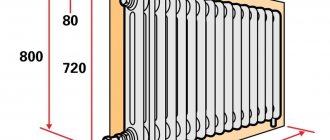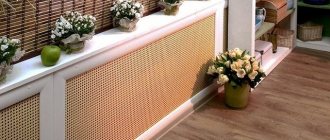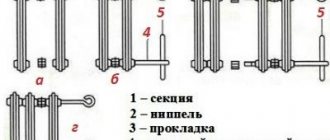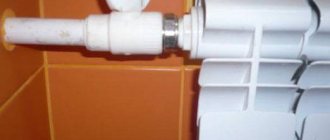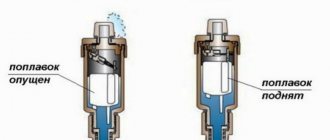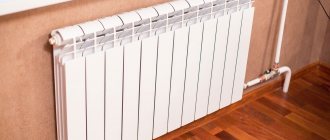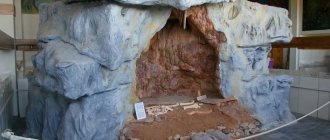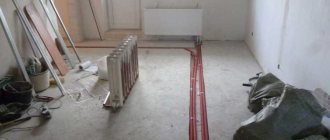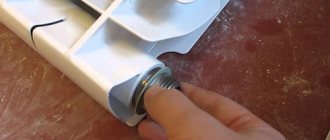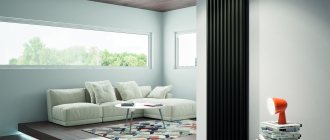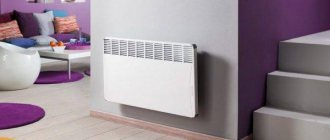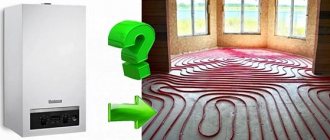Decorative grilles for heating radiators have become widespread. A wide range of models, differing in design, color, material of manufacture, method of fixation, fit harmoniously into any interior - from classic to modern. At the same time, the products perform the main function - they do not interfere with the effective heating of the living space.
Overlay facade on a heating radiator
Why do you need a battery screen?
A correctly chosen decorative screen will not only disguise the unpresentable appearance of the radiator, but will become a natural addition to the interior, emphasizing its style and color scheme.
Plastic screen in a modern style
There are several functions that radiator screens perform:
- Being a technical device with protruding elements - sharp edges, taps, valves, the heating radiator carries some danger. It is also worth considering that sometimes the surface temperature of the battery is quite high and touching it can cause a burn. Therefore, the screen performs a protective function . This is especially true in families with small children.
- Due to the correct choice of material for making the product, optimal selection of the location and size of the holes, it is possible to improve the convection of the battery and increase the efficiency of the heating process . For example, using a metal screen model you can increase the heating area.
- The decorative possibilities of the radiator screen are obvious - the battery does not always look appropriate in the interior. With its appearance, it can spoil the entire impression, “break” a finely calibrated and thoughtful design concept. The overlay, made in the same style as the interior, will fit organically into it and will not stand out from the general background.
- Due to their design, old-style batteries are most susceptible to rapid contamination of hard-to-reach places where dust and debris accumulate. It takes a lot of time and effort to keep such a structure perfectly clean. With the help of the screen, the issue of cleanliness is solved radically - the battery is reliably protected from contamination , and the screen itself does not require complex care and always looks neat.
The perforation pattern is selected taking into account the design style of the room
Screen manufacturing materials
Decorative protective structures for batteries are made from different materials. This affects the characteristics and price of the equipment.
The choice of the optimal model depends on the features of the interior, budget and taste of the owner of the room. The main condition is that the radiator screen must cover as much as possible the externally unattractive heating equipment and have sufficient perforation for high-quality heat transfer.
An important parameter when selecting materials is the operating temperature of the heating system. A well-chosen radiator screen will retain its attractive appearance, color and configuration for a long time
Option #1 – metal grilles
Radiator screens made of aluminum mesh or thin sheet steel are in high demand among consumers.
If the design involves the presence of large holes, then the grille perfectly transmits heat without trapping hot air flows in a closed space.
Despite the fact that the metal has high thermal conductivity, due to the reduction in surface area, a decrease in thermal power is observed.
Metal products differ in size, shape, color and pattern design. Consumers can choose openwork grilles or screens in the form of a continuous canvas. Some models are equipped with a side panel.
The service life of metal products depends on the type and quality of paint. The best option is powder enamel. It protects the metal from corrosion and remains on its surface for a long time.
A forged metal screen is a multifunctional product that will decorate any interior. Since the original material is visible under the openwork forging, it is better to cover the heating device with a thin perforated metal sheet
Metal radiator screens have the following features and advantages:
- Large range of models. Today you can buy products of different designs, ranging from expensive forged structures with decorative elements to standard hanging screens with perforations.
- The color of the grille must be selected to match the heating device in the apartment or the interior of the room.
- The metal has increased thermal conductivity, so it increases the area of thermal energy release by 2-3 times.
- The metal surface is easy to clean; dirt can be easily removed from it using a damp sponge.
- Metal does not have the property of deforming and changing its appearance due to changes in temperature or humidity.
- If there is perforation, the metal heats up and becomes an additional source of heat in the room.
Metal grilles are easy to install and can be easily and quickly removed for cleaning or replacement. And with proper care, this material has a long service life.
Metal screens are the most affordable enclosing structures. Metal gratings are often made by hand. To make a decorative element, it is better to use stainless steel or galvanized steel, which are not afraid of corrosion.
Option #2 – wooden gratings
Unique products are made from wood, suitable for rooms decorated in any style. Decorative elements made from expensive species belong to the premium class. Even inexpensive types of wood are used to create original compositions.
It is important that the radiator grille has perforations, since a product without holes will transfer some of the heat to its neighbors.
Decorative radiator screens made of oak, beech and other valuable wood are often found in classic interiors. They are usually tinted, painted and coated with high-quality enamel.
The main advantages of wooden products:
- are characterized by strength and increased wear resistance, which ensures a long period of their operation;
- visually attractive grilles made of natural wood will decorate a room for any purpose;
- natural wood is universal, it harmoniously combines with various finishing materials;
- wood is plastic in the skillful hands of a master who can create a work of art from it with unique carved fragments.
Wood is sensitive to high humidity and temperature changes. Therefore, in order to produce a high-quality product with a long service life, manufacturers must carefully select raw materials.
The material must be durable; according to the technology, it must be properly dried and treated with a protective composition.
To cover old cast iron batteries, it is better to use wooden grilles made from natural oak or beech wood. They are characterized by increased strength, aesthetics and durability.
Wooden radiator grilles can be painted or not, tinted or enameled. So that they do not interfere with the normal passage of heat flows, they are often mounted not on the floor of the room, but raised above it a short distance.
To improve air circulation, holes are usually made on the top part of the box.
Wooden grilles are often installed in children's institutions, as they allow the heating system to be closed as much as possible. Inexpensive screens made of slatted fabric perfectly perform protective functions and allow warm air flows emanating from heating devices to pass through.
Option #3 – plastic covers for radiators
When manufacturing products, it is important to use material with a heat-resistant composition that can withstand temperatures of 70 °C. The best option is durable PVC, which when heated does not tend to deform and release harmful substances.
The pliable material allows manufacturers to produce models of original colors and shapes.
The advantages of a plastic screen are as follows:
- the product is lightweight, which makes it easy to transport;
- the material is not afraid of moisture, the grille can be used in rooms for various purposes;
- plastic is not subject to corrosion and is resistant to temperature changes;
- ease of installation and dismantling of equipment;
- easy care - the plastic surface is easy to clean without abrasive cleaners;
- Plastic screens are inexpensive.
The main disadvantage of plastic is low thermal conductivity. When significantly heated, the material begins to release harmful toxic substances, which is why plastic grilles are not used in children's institutions. Most often they are installed in office and non-residential premises.
Cheap material is characterized by low mechanical strength, so radiator screens are made of thicker plastic, which leads to significant heat loss.
Inexpensive plastic grilles are available in a wide range of colors and sizes. This allows consumers to choose the winning option for premises of any purpose.
Option #4 – glass screens
When decorating modern residential premises, glass radiator screens are in particular demand. They mainly perform an aesthetic function - they have a stylish design, so they can transform and decorate any room.
Many consumers choose glass models, as they are distinguished by high technical characteristics, aesthetic appearance and environmental friendliness.
Manufacturers offer glass radiator screens of different types:
- transparent;
- matte, with aesthetic sandblasting;
- decorated with UV printed images;
- made of tempered or plain glass;
- combined with other material or completely glass.
In order to give strength to the edges of the product, manufacturers use bevelling and polishing technology. This treatment ensures safe operation and an attractive appearance of the product.
A special substance is applied to the glass, which has protective properties and allows you to clean the screen using regular detergents.
The glass screen for the radiator is chosen taking into account the features of the interior. A decorative product will stylishly decorate a residential or office space
You can make an exclusive panel from an ordinary radiator. Using UV printing technology on the screen, which is a functional design element, you can apply a picture with a city panorama, flowers, animals or birds.
Options for decorating products: painting, tinting, deep etching, photo printing, satin finishing.
Glass screens have many advantages:
- high heat transfer rate;
- allow you to give old-style batteries a modern look;
- a large selection of stylish decorative products;
- if necessary, you can easily dismantle it;
- Tempered glass has a thickness of 8 mm, due to this it is practically impossible to break.
Radiator screens made of acrylic glass are popular. It is up to 2.5 cm thick, but weighs much less than usual.
Thin acrylic glass comes in a variety of colors and can warp when exposed to high temperatures. The bending technology allows you to give it the required shape and create an exclusive product.
Glass radiator screens do not reduce convection and provide free thermal radiation, since cold air enters from below and warm air rises to the top
Option #5 – HDF and MDF box
Decorative grilles made from HDF and MDF boards are budget models. They imitate natural wood, making them inexpensive and attractive. The products are not afraid of moisture and sudden temperature changes.
Boxes made of HDF and MDF differ in shades and shapes, which allows you to choose the optimal model for any interior. MDF and HDF boards can serve as the basis for natural wood products to reduce their cost.
HDF structures are thinner than wooden ones, so they make attractive openwork grilles. Due to the presence of perforation, the products have excellent thermal conductivity
Radiator screens made of MDF and HDF have the following advantages:
- Simple processing . The surface of decorative elements does not require additional painting.
- Good assortment . A wide variety of models in different shades and colors allows you to choose an option for any room.
- Easy care . To clean products made from this material, you can use conventional products for polished surfaces.
- Affordable price tag . Radiator screens made of MDF and HDF are characterized by a relatively low, budget cost.
For the production of decorative screens, natural components are used, and natural lignin acts as a binder, so the products are safe for health.
HDF is pressed using special equipment under high pressure, resulting in a thin material with a dense and uniform structure.
How does the screen affect the heating process?
In pursuit of the external beauty of the product, one should not forget about its functionality - the screen should not interfere with effective heat exchange in the room. Do not be afraid that after installing the grille on the radiator, heat will be retained, which will provoke an increase in home heating costs. If you select the right design, such problems will not arise. Moreover, with the help of a special layout and configuration of the screen elements, you can even increase the amount of incoming heat.
The larger the holes, the more efficient the heat transfer
If you understand the operating principle of a standard heating radiator, then there will be no problems with choosing the correct design of a decorative screen.
Operating principle of a heating battery
When heated, the heating radiator transfers heat into the room as a result of the movement of heated air masses (convection process) and through direct thermal (infrared) radiation.
The principle of operation of the radiator
The effectiveness and priority of each of the two thermal energy transfer options may vary. This is influenced by the design of the radiator, the temperature of the coolant and air in the room, and the presence of obstacles in the path of heat flow.
So, at not too low temperatures, cast iron batteries give off heat according to the principle of convection, but after the coolant temperature rises to 70 degrees and above, heat is transferred using infrared radiation.
Main methods of heat transfer
Conclusion. Maximum efficient operation of a heating radiator can be achieved with efficient heat transfer using both methods.
So, in order to ensure free air circulation, the converter radiator is equipped with a grille that does not have an upper horizontal panel.
Warm air distribution
Prices for popular models of heating radiators
Heating radiators
What to consider when choosing a grate
The main rule that must be observed when choosing a grille is that its design should not interfere with the free circulation of heated air and the passage of infrared radiation . This is possible if the front panel of the grille is equipped with a sufficient number of holes, amounting to at least 50% of the total area, and the free passage of warm air is ensured above the battery.
The holes at the top should not interfere with convection
It is also recommended that the material used has excellent thermal conductivity and allows air to flow freely into the room. If the inner surface of the screen is painted black or dark brown, the heat absorption will be better.
Purpose of decorative grilles
A well-chosen protective grille should not disturb the harmony of the room. Its task is to become an excellent stylistic addition to the interior and an effective camouflage device behind which an unaesthetic battery is hidden.
The functional purpose of the radiator is to heat the room. Therefore, the protective screen should not interfere with effective heat transfer.
If this element retains heat, the room will become cold, and additional heating sources will have to be used, and this entails an increase in utility bills.
But you can choose a grille configuration that will not only hide the radiator, but also increase the flow of heat into the room.
In addition to hiding the surface of the battery, the decorative grille performs protective functions. Firstly, the screen protects the radiator from dust and contamination. Secondly, it doesn't get as hot as a battery. This means that you can touch it without fear of getting burned. This is especially important for families with children or pets.
In addition, the screen can be quickly dismantled for the purpose of prevention, repair or replacement of the heating device.
What material are decorative grilles made of?
Protective screens for batteries are made of different materials: aluminum, steel, copper and bronze, wood, MDF, glass and plastic. Each of these materials has certain qualities that affect the appearance, method of fastening and energy efficiency of the product.
The material of manufacture must be combined with the decoration of the room
The main condition is the non-toxicity of the material after heating and the absence of a specific odor.
Tree
Decorative screens made from natural wood fill the room with a special atmosphere of comfort and warmth. The popularity of this material for the manufacture of battery covers is due to the natural origin of the material, its unique natural pattern and texture, flexibility in work and the unique property of releasing natural phytoncides and antiseptics into the environment when heated, forming an optimal, healthy microclimate.
Wooden model in modern style
Wood, depending on the species, has a certain softness and is easily amenable to artistic processing. This property allows you to make a screen in any style - from classic to modern.
Carved screen
As for the cost, this is the most expensive option . Often made to order according to individual measurements and sketches. The type of wood also affects the cost. On average, the cost of making custom-made products starts from 5,000 rubles.
Minimalist style for efficient heating
Wood is afraid of exposure to moisture and temperature changes . You can protect it by treating the finished product with several layers of water-based varnish.
Classic design
Note! Wooden screens are not compatible with converter-type radiators, since the design of the grille requires the installation of a top panel that will completely or partially block the exit of warm air.
The color scheme of the product should be organically combined with textiles
Rattan structures have excellent thermal conductivity . They are characterized by the decorative properties of natural materials and high thermal conductivity.
Metal
For the manufacture of metal gratings, a perforated metal sheet with a mosaic decorative pattern made of holes of various shapes is used. This panel is distinguished by high heat transfer , neat and elegant design .
Metal grate
This also includes mesh gratings , the cells of which have different shapes and sizes.
The metal surface can be not only painted in a single color, but also with a complex pattern - imitation of wood species.
Hinged mesh protective screen with side walls
When painting metal screens, a powder coating method is used. This helps protect the metal from corrosion and increases the surface’s resistance to mechanical stress and fading.
The advantages of a metal screen for a radiator include the following:
- Easy installation and dismantling.
- Light weight.
- A wide range of.
- Affordable price.
- Easy care.
- Moisture resistance.
- Versatility.
- Possibility of updating and changing colors.
- High thermal conductivity.
- Durability.
- Resistance to deformation when exposed to high temperatures.
A hinged screen without side walls does not obstruct air circulation
Separately, it is worth noting forged metal gratings, made to order, which have significant weight and high cost.
Glass
Modern glass panels for heating radiators have a lightweight, sophisticated design. The cost of such products is quite high . On the front side, decor is applied to the panel using a technique that allows you to work with glass - this can be photo printing, tinting, sandblasting. The externally fragile product is actually triplex with a thickness of at least 8 mm - breaking it is quite problematic .
Stylish glass screen with photo printing
A solid screen completely covers the battery, and warm air flows penetrate through the top and bottom - by convection. In this case, infrared radiation does not pass through.
The advantages of glass screens include the following:
- Affordable cost (compared to wood products).
- Environmental friendliness and safety of the material.
- Easy installation.
- Decorative, original and customizable.
- High temperature resistance.
- Easy care.
Frosted glass - universal decor
Plastic
Plastic screens can be made entirely of PVC or have a metal base. The surface of a plastic product can imitate any type of wood, stone and other textures.
Plastic construction
The cost of plastic products is low , but so is their thermal conductivity . The service life of the products cannot be called durable either, although high-quality plastic has the necessary strength and heat resistance.
Plastic is easy to clean , but it is worth remembering that detergents should not contain abrasive particles.
MDF screen
Along with plastic, a budget material for the manufacture of radiator grilles is MDF, which imitates the texture of real wood better than PVC.
MDF construction
MDF boards have excellent performance properties:
- They have an aesthetically attractive surface.
- Resistant to temperature changes.
- Not subject to deformation.
- They are moisture resistant.
- Available in a wide range of shapes and shades.
The design can imitate a fireplace with a shelf
In the manufacture of wooden models of screens, MDF can be used to reduce the cost of construction in the manufacture of hidden structural elements. The advantage of MDF over wood is its higher resistance to mechanical stress .
MDF can be processed, which allows you to diversify the design of products
MDF is artistically cut, so the grille can be decorated with fancy patterns and designs.
Variety of shades and types of perforation for MDF screens
Battery grilles: types, sizes, installation
Heating batteries do not always have an aesthetic appearance. This is especially true for old massive products that can no longer be restored. To hide radiators, special decorative grilles are used. They come in different types, styles, colors and are designed to suit different budgets.
The principle of heating a room
Metal screens for radiators
Decor is the main function of battery grilles. But radiators are used to heat the home, so there should be no obstacles in the way. Even the thinnest screens reduce heat transfer, so you should choose products with a low percentage of absorbed heat in advance.
Air should enter the radiator from below, pass along it, heat up and go to the top. This system will heat the room. Therefore, when choosing a grill for the battery, you need to make sure that there is a small gap at the bottom and that there is no cover at the top. It is possible that the top cover has a large perforation area.
Many modern decorative radiator grilles reduce heat transfer by more than 20%. Screens in the form of boxes made of solid wood lose a particularly large percentage of heat. Models with a minimum number of holes and a small perforation area will be ineffective in operation.
The screen additionally protects the radiator from dirt. Dust particles settle on a hot battery and decompose under the influence of high temperature. As a result, the surrounding atmosphere becomes polluted with decomposition products, which harms the health of people, especially allergy sufferers and asthmatics. When installing the grille, the accumulation of dust on the radiators is significantly reduced. Periodically you need to clean the screen with a cloth or vacuum cleaner.
Purposes and materials of gratings
The principle of heating a room using a heating radiator
In addition to their decorative function, grilles perform a protective function. They allow you to hide and round off sharp and hard edges. This is especially true if there are small children in the house who may be injured. Radiator screens also prevent you from getting burned on hot pipes.
Screens are made from the following materials:
- Metal. One of the most popular screen materials for radiators. They are made of thin steel, which is then painted. The duration of operation depends on the quality of painting. They are considered the most optimal, since they practically do not cause heat loss. The metal heats up quickly and radiates heat itself, so the room will not be cold. The advantages include a long operating time, which reaches several decades, as well as low cost. The disadvantage is that the appearance is not the most aesthetic. There are forged models, but they need a background.
- Wood.
Wood is a top-class material. It is environmentally friendly, looks stylish and allows you to create grilles of different shapes. Even inexpensive wood models look beautiful. But battery efficiency behind a wooden screen is significantly reduced. It takes a lot of time to heat up wood. Application of wooden screen for heating radiator - Plastic. For bathrooms and bathrooms, it is optimal to use plastic screens. The material is distinguished by its hygiene, durability and ease of care. To keep the plastic grill clean, just rinse it. For battery screens, heat-resistant plastic is used that can withstand heating up to 60-80°C.
- Glass. Such material is rarely used due to its imperfection from the point of view of the heating function. They look stylish and beautiful and fit into any home interior. They are made of tempered glass, which is then frosted or painted. It is distinguished by quality and reliability, as it is made from durable materials.
- PVC.
Screens made of this material can be made either on a metal base or on a PVC frame or with rattan inserts. Features a wide variety of designs. There are models in wood, marble, cut stone, and metal. The thermal conductivity of PVC is lower than that of metal and wood, so more fuel will be required to heat your home. The material is characterized by heat resistance, durability, and the absence of release of harmful and toxic substances when heated. They have an affordable price. Glass screen for heating radiator - MDF. Wooden models are expensive, so many people replace them with MDF counterparts. This material is also environmentally friendly and stylish, and the price on average is 1000-1500 rubles per unit. The product may not be entirely made of MDF - for example, there may be metal or wood inserts. The grille withstands temperature fluctuations, high humidity and other negative external factors without visible deformation. Negative qualities include the heavy weight and laboriousness of removing the system.
You can find radiator grilles made of exotic materials - these include bamboo and rattan. They serve only a decorative role and do not fit into every interior, so they are rarely used. There are also combined models on sale. A classic example is a wooden frame on which a decorative mesh made of another material (bamboo, MDF and HDF panels) is stretched.
Advantages and disadvantages of different materials
Wooden screens for radiators have a high degree of heat transfer
Wooden models have the following positive qualities:
- Durability. When used correctly, wood practically does not lose its properties.
- Reliability.
- Environmentally friendly. Wood is a natural material that does not emit harmful substances.
- High degree of heat transfer.
Main disadvantages:
- Bulk wooden gratings do not withstand temperature fluctuations well. Some models may become cracked after just a few seasons.
- Duration of wood heating.
You can apply any design to the glass screen to suit your interior.
Glass screens are used infrequently. But they have the following advantages:
- The price is lower than that of wood.
- Ease of installation. Any technician can install a radiator grille.
- Stylish appearance. You can apply drawings and photographs to the screen using thermal printing to suit any interior.
- Safety, ease of care, high degree of heat resistance.
The disadvantages of glass models include fragility. Cheap products may be made of thin glass, which makes them prone to accidental breakage. High-quality, expensive screens are made of durable material that is almost impossible to damage.
Plastic screens are easy to maintain and also have a low cost.
The advantages of plastic models are as follows:
- Attractive price. You can find a radiator screen for any budget.
- A wide range of. There are shapes and colors to suit any interior.
- Easy to care for. Plastic products can be washed an unlimited number of times.
Flaws:
- They quickly lose their attractive appearance.
- When heated, harmful substances may be released. They can negatively affect people's health. Such models are prohibited from being installed in medical institutions, kindergartens and schools.
The advantages of metal screens include resistance to temperature fluctuations and ease of installation
Advantages of metal models:
- Practicality. The screens are unpretentious and can be installed in any conditions.
- Resistance to temperature fluctuations.
- Strength. Metal is practically resistant to mechanical stress and vibration.
- Metal gratings are not affected by changes in pressure and humidity.
- Easy to install. They are also easy to dismantle.
- Low cost. Associated with the simplicity of manufacturing technology.
- Duration of operation. Associated with the unpretentiousness of the material and lack of response to external influences.
- Wide selection of models. They are presented in all price ranges.
The disadvantages of metal include the difficulty of making it yourself. In this case, it is better to buy a ready-made model or order it according to individual sizes and characteristics.
The rest of the materials are practically not used.
Types of screens
Box-shaped screens are not often used due to the high percentage of heat loss
The classification of grilles for heating radiators is also made by design. Each type is used for a different type of battery and is designed for different installation methods.
Flat screens are used if the radiator is mounted in a niche. Then the flat panel is fixed to bars, which are fastened along the perimeter of the niche. Glass grilles are attached to special pins in the same way. These types of screens are called “facades”.
There are two types of hanging grilles - with and without a lid at the top. The first ones are placed on accordion-type batteries that protrude beyond the window sill. The shape of the top cover is made such that the grille can be fixed to the radiator. Products without a cover are attached to the upper radiator manifold using hooks that are fixed on the front panel.
Boxes are used infrequently due to the high percentage of heat loss. Air circulation in such models is difficult. Necessary if you want to cover the sides of the battery. According to the method of fixation, boxes are distinguished that can stand without support on special legs and require mounting on the wall.
Fixation Features
Mounting a screen box for a heating radiator on the wall
The main requirement for radiator grilles is the ability to quickly access heating appliances and pipes. This is due to the need to periodically clean the heating elements from dust and dirt. It is recommended to clean twice a year. There are also emergency situations in which the technician must have easy access to the failed area. It is important to think through such a fixation system in advance so that you can easily remove the screen if necessary.
Mounted and attached screens meet this requirement. They can be removed in a few seconds and installed just as quickly. Problems arise with flat and closing radiators, as well as boxes. It is recommended to attach such models to the wall using two slats - one on the box, and the second on the wall. The top edge should be beveled towards the grille. When installing the grille, this part acts as a lock, which can be easily removed if necessary.
There is another installation option. You can put metal elements (for example, plates) on one bar, and magnets on the other. Then there will be no problems with removing and installing the grilles.
Flat screens can also be attached with hooks or loops. They are easy to make, but they can be difficult to install and fit into the loop. Sometimes they also install a decorative version of grilles with sliding doors.
Making your own grating
Scheme for making a screen for a radiator with your own hands
Stores offer a huge range of screens made from different materials, with different shapes, designs and colors. But if you wish, you can make a decorative lattice yourself with your own hands. The work is not difficult; all the necessary materials can be purchased at any hardware store. No professional equipment required.
To create a screen for the battery, you will need the following tool:
- Grill material. MDF or chipboard is usually used, as they are the easiest to work with.
- Hacksaw.
- Construction adhesive.
- Sheet steel mesh for front and sides.
- Metal sheet for reflector.
- Nails, screws, fasteners.
- Tape measure, pencil.
The first stage is measurement. It is necessary to measure the height and width of the radiator. For each value obtained, add 1
You can make a screen grille or a complete frame from metal
0 cm. You can add a little less to the height - 5 cm. Next, the depth of the battery is measured, and 2.5 cm is added to its value. The size of the future cover is measured in the same way. Its final dimensions should exceed the dimensions of the sidewalls by 2-3 cm.
Cutting parts. The front part is created from sheets of MDF or chipboard. Rectangular parts approximately 11 cm wide are cut out of them. Angles of 45° should be made in the touching areas for ease of connection.
A metal reflector is installed on the back. The dimensions should be approximately the same as the decorative cover. It allows you to reduce heat loss and direct infrared waves to the center of the room.
Next, a sheet steel mesh is installed. It acts as a frame onto which all previously cut elements are then assembled.
After the grille is assembled, you can install it on the battery.
If it is not possible to make the screen yourself, you can place an order according to individual sizes.
What types of screen designs are there?
Radiator grilles differ in design and in the method of their fixation. Thus, lightweight screens of small thickness are placed over batteries. And products made from natural wood, due to their heavy weight and massive structure, are fixed to the floor and walls. In this case, it is necessary to provide access to pipes and valves using a removable grille.
Advantages of decorative grilles
Table 1. Types of decorative screens.
| Illustration | Construction type | Description |
| Flat facade | Used when the battery is located in a niche - existing or mounted from plasterboard. | |
| Hinged screen | Mounts on top of radiators. Can be equipped with a perforated lid. | |
| Box | Covers the battery on all sides. The top is made in the form of a solid or perforated table top. Not the best option, as it interferes with air circulation. |
Prices for radiator grilles
Radiator grilles
Video - Overview of battery screens and grilles
Brief instructions for self-installation
Having decided on the choice of the appropriate option, you can begin installation work. Such activities can be completely implemented independently, without the involvement of a specialist.
The main thing is to arm yourself with the required materials and tools:
- self-tapping screws,
- plywood,
- wooden slats,
- hammer,
- screwdriver,
- nails
- furniture stapler,
- grating (slat),
- glue,
- hacksaw.
The initial stage is characterized by measuring the parameters of the heating device - width, height, etc. Allowances (several centimeters) are added to the obtained values. Then the gap between the wall structure and the grille on the heating radiator is measured, where a distance is also left for normal air circulation.
Next, the frame is made using slats. Using self-tapping screws, it is installed into the wall surface. Perhaps the created structure will protrude a little, which is not critical - the frame will become a continuation of the window sill.
The formed structure is then covered with prepared plywood or chipboards replaced with it.
Thin slats are used to make gratings; fabric strips can be used instead. If it is necessary to create a decorative pattern, you can fill the remaining slats on top of them, for example, making a square shape.
A self-made screen for a battery will become a unique element of the interior, because personal design input and labor were made into its formation.
The process of forming a coating for a radiator is not so labor-intensive as it requires attentiveness, accuracy and pre-thought-out stages of technology. Of course, it is worth taking care of proper air circulation to avoid problems with heat transfer.
Installation of a metal box - step-by-step instructions
The method of fixation and design of the decorative screen should provide easy access to the battery for its maintenance and prompt resolution of emergency situations. An attached or hinged metal screen has similar qualities.
Lightweight mounted model
Table 2. Step-by-step instructions for installing a metal box.
| Illustration | Description |
| Step 1. Before you go to the store to purchase a finished product or order a screen based on individual data, you need to take all dimensions: depth, height and width of the product. | |
| Step 2. Markings for fasteners are applied to the wall. First, mark the line. | |
| Step 3. Points for drilling are marked on the line. | |
| Step 4. Drill holes for dowels. | |
| Step 5. Dowels are inserted into the finished holes. | |
| Step 6. Screw in the screws. | |
| Step 7. There should be a free space of 1 to 2 mm between the wall and the screw head. | |
| Step 8. The screen is hung on self-tapping screws |
Why do you need a protective mesh for the radiator grille?
First, let's figure out what functions the radiator itself performs. The radiator is one of the main elements of the car's cooling system, which is located in the nose near the bumper.
During operation, a spark is formed inside the internal combustion engine, which ignites the fuel. It, in turn, releases thermal energy, which is subsequently converted and becomes the driving force for the car. It's no surprise that the engine gets hot all the time. However, overheating of this part can cause partial or complete breakdown of the car. Therefore, cooling is a necessary process for the proper operation of the car.
This is precisely why automakers invented the radiator. It is a system of metal plates and tubes through which coolant circulates. A grille is installed on the outside, which covers the technological openings for oncoming air.
A car radiator is one of the main elements of the cooling system.
Unfortunately, the radiator grille has rather large cells, so it often gets dirty due to particles of dust, sand, gravel and even insects flying into it. Not all motorists pay enough attention to cleaning this element of the car. Professional car washes are guilty of the same thing. Large amounts of debris prevent the cooling system from functioning properly, which can lead to overheating and engine failure.
This is what an unprotected car radiator looks like after use.
Some car manufacturers make fine-mesh radiator grilles, but they rarely equip cars with them from the factory. If you are the owner of a popular model, and for some reason do not want to install a mesh, look for similar grates on sale. However, be prepared that the price will be much higher.
Radiator grilles with small meshes are available for sale, but their cost is higher than that of conventional grilles.
A protective mesh, which is installed on the inside or outside of the grille, will help to avoid this. Its small cells prevent even the smallest insects from entering the radiator. In addition, it is quite easy to remove and clean. At the same time, it does not have a negative effect on the oncoming air flow and does not interfere with the operation of the system.
The protective mesh will protect the car radiator from contamination
Why will I install a grid?
My father has a minivan, it’s hot, they’re driving south, a stone flies out, breaks through the plastic grille of the bumper and breaks through the air conditioner radiator. The sensations were higher than sexual. Parents and children at +30 without air conditioning... I think that catching a stone in the city is almost impossible, but birds, stones, etc. on the highway it was once a year for sure. renby
www.drive2.ru
Mesh on the outside of the grille
Most often, the mesh is installed on the outside of the radiator grille. This method has many advantages:
- you don’t have to dismantle the bumper and grille to install the mesh;
- such a mesh is easier to remove and clean;
- the grill itself will also remain clean;
- You can diversify the appearance of the car.
There is no need to worry that such a mesh will ruin the appearance of your car. On sale you can find nets with an original design that will only decorate the exterior.
A protective mesh can be installed in front of the radiator grille
. However, not everyone likes such changes in the appearance of the vehicle. If for this and any other reasons you do not want to mount the mesh from the outside, there is another method for you.
From the inside
In cars of a high price category, even the radiator grille is a design element. Just remember BMW cars: their grilles cannot be confused with any others, they fit so organically into the overall image. It's not surprising that many motorists don't want to hide them. In this case, the method of installing the mesh from the inside comes to the rescue.
The protective mesh can be installed behind the radiator grille
The mesh hidden under the radiator grille will not be conspicuous. At the same time, it will protect against all contamination no less effectively. However, installing an internal mesh also has its drawbacks. For example, the need to dismantle the grill itself. And some cars are designed in such a way that the grille can only be removed together with the bumper. This will take you extra time and effort, but the overall design of the car will remain more harmonious.
In any case, the choice between appearance and effort is up to you, because the functionality of the part will not decrease.
Making your own plasterboard box - step-by-step instructions
You can make a neat plasterboard box for fixing a flat decorative screen yourself .
Table 3. Step-by-step instructions for making a plasterboard box.
| Illustration | Description |
| Step 1. A guide profile for drywall (27 x 28) is used to make slats, the length of which is equal to the parameters of the structure being manufactured. | |
| Step 2. A profile is placed into the guide on one side. | |
| Step 3. Make holes. | |
| Step 4. The frame is assembled, controlling its geometric parameters using a building level. | |
| Step 5. Fix the drywall panels. | |
| Step 6. A hole is cut in the drywall and a decorative screen is installed. |
After installation, the box is painted in the desired color to match the interior of the room.
In addition, we recommend you our article on the topic - Wooden balusters, where we looked at their types, as well as step-by-step instructions for making them yourself.
How to make a protective mesh for a grill with your own hands
Ready-made protective nets can be made from materials such as:
- aluminum;
- steel;
- carbon;
- plastic.
Aluminum is a lightweight but durable metal that does an excellent job of protecting the cooling system. Steel meshes are no less effective. Carbon meshes are commonly used to protect the radiators of sports and racing cars, but they are expensive.
The most popular material for making your own mesh is ordinary plastic. It is easy to work with, and its cost allows for some mistakes.
Materials and tools for tuning
To work, you will first need the mesh itself, which can be purchased at almost any hardware store. Chain-link mesh is perfect for these purposes, although other options are also acceptable. The material, be it plastic, aluminum, steel or even carbon, is at your discretion.
Chainlink mesh is well suited as a base
When purchasing a mesh, especially a plastic one, pay attention to the mesh sizes. Too small ones can negatively affect air intake.
So, to work on the mesh you will need:
- the mesh itself;
- paper;
- ordinary scissors and metal tools;
- metal cutters;
- pencil and marker.
DIY creation
All your further actions depend on the shape of the radiator grille. If it is fairly even, with relatively right angles and clear lines, you just need to measure the length and width of the lattice, and then cut the mesh in accordance with these parameters. However, manufacturing becomes significantly more complicated if the part has a complex shape with a large number of bends or sharp corners.
In order to make a pattern, you will need to do the following:
- Attach a sheet of paper (or glued sheets) to the radiator grille. Press firmly so that you can clearly see its shape, and then trace along the outline.
- Cut out the resulting shape from paper.
- Attach the pattern to the mesh and cut it out. If you are going to install the mesh on the outside of the grate, be sure to leave allowances of about 0.5 cm on all sides.
- Use pliers to remove all excess.
The process of making a protective mesh in the photo
Cut out a pattern from paper that matches the shape and size of the radiator grill Cut the mesh according to the pattern Cut off all the excess and your mesh is ready
On some cars, the logo is located directly on the radiator grille. Consider its shape and size if you are making a mesh for external installation. Logos of a simple shape, such as those of Renault cars, can be cut out with wire cutters. In more complex cases, you will have to remove the nameplate and attach it over the mesh.
If the mesh is too fine and soft, you can use a second mesh with larger cells as a frame. Cut out the desired shape using the same principle, and then connect both parts.
Your mesh is ready. Now all that remains is to paint it and install it on the grill.
Cost of decorative screens
An important role when choosing a screen for a battery is played by its cost - sometimes it is decisive. Prices for these products range from 230 rubles. up to 8000 rub. and higher depending on the material of manufacture.
Table 4. Average cost for some types of decorative screens
| Illustration | Material | Dimensions, mm | Average cost as of March 2021, rubles |
| Steel | 610 x 690 x 142 | 740 | |
| MDF | 600 x 600 600 x 900 600 x 1200 600 x 1500 | from 960 | |
| HDF | 610 x 1210 x 3 | 1000 | |
| HDF | 600 x 900 x 200 | 2000 | |
| HDF | 610 x 910 x 3 | 890 | |
| HDF | 600 x 900 x 5 | 695 |
DIY screen for a heating battery
Today, few people can be surprised by design solutions for the design of heating radiators.
Much less common are ordinary, unadorned and undesigned radiators. The main decorative techniques are creative painting or a screen - an aesthetic coating that does not interfere with the movement of warm air. And if you learned about painting radiators and choosing odorless paint in our previous article, then here we will talk about how to make a screen for a heating radiator with your own hands, with detailed photos and video instructions. How? Read on. In addition to the fact that the screen performs a decorative function, one cannot fail to mention its rich functionality. On the one hand, it prevents dust from accumulating in sections of the radiator, where it is very difficult to reach. On the other hand, it protects children from injuries and burns. Some craftsmen manage to turn ordinary screens into transforming tables that recline when necessary. Often small hooks are installed on such screens, which allows you to dry clothes in winter.
Important! A properly made screen does not interfere with the movement of warm air from the radiator. It is noteworthy that such a decorative element can cover any type of radiator
Although some of them, for example, design radiators, are exclusive in themselves, so they do not need additional decor. You can learn about such radiators in our article “Steel heating radiators"
It is noteworthy that such a decorative element can cover any type of radiator. Although some of them, for example, design radiators, are exclusive in themselves, so they do not need additional decor. You can learn about such radiators in our article “Steel heating radiators”.
Purposes and materials of gratings
In addition to their decorative function, grilles perform a protective function. They allow you to hide and round off sharp and hard edges. This is especially true if there are small children in the house who may be injured. Radiator screens also prevent you from getting burned on hot pipes.
Screens are made from the following materials:
You can find radiator grilles made of exotic materials - these include bamboo and rattan. They serve only a decorative role and do not fit into every interior, so they are rarely used. There are also combined models on sale. A classic example is a wooden frame on which a decorative mesh made of another material (bamboo, MDF and HDF panels) is stretched.
Advantages and disadvantages of different materials
Wooden models have the following positive qualities:
Glass screens are used infrequently. But they have the following advantages:
The disadvantages of glass models include fragility. Cheap products may be made of thin glass, which makes them prone to accidental breakage. High-quality, expensive screens are made of durable material that is almost impossible to damage.
The advantages of plastic models are as follows:
Advantages of metal models:
The disadvantages of metal include the difficulty of making it yourself. In this case, it is better to buy a ready-made model or order it according to individual sizes and characteristics.
The rest of the materials are practically not used.
